By Josh Ritter
Here is the fundamental problem…most of us have no idea how to get to know our neighbors. The solution is both simple and far-reaching. We must learn to communicate well.
The biggest issue is that most people communicate through assumptions based on overly simplistic labels of identity. “Oh, you’re a Republican.” “Oh, you’re a liberal.” “Oh, you’re a Muslim.” “Oh, you’re a Christian.” Everyone thinks they know what these labels mean even though everyone’s identities are highly complex and vary from person to person. Not everyone who identifies as a Republican is only a Republican, and not everyone who is a Democrat is only a Democrat. We all have multiple identities that intersect and form who we are and who we become. Our identities shape how we interact with each other, and they inform the decisions that we make.
Part of the solution, then, is realizing that we are all complex, complicated people. The other part of the solution is realizing that living in community is messy, complicated, and difficult. We all want everyone to agree with us, but they often don’t. We all want everyone to believe the way that we do, but they often don’t. Should we just settle for agreeing to disagree? Or, is there more to communication and community than living within the compromises?
At work here is the root of communication and community – communion. Yes, communion…in the sense of “the sharing or exchanging of intimate thoughts and feelings, especially when the exchange is on a mental or spiritual level.” Living within community is a sacred journey with our neighbors. Living within community is a sharing and exchanging of thoughts and feelings, even when we disagree, which requires a level of trust that most of us simply do not extend to our neighbors, but it is this trust, this sacred vulnerability, that is precisely the necessary piece of the civic puzzle that we must fill in order to live in community and to neighbor well.
So how do we develop trust among strangers (that are also our neighbors)?
Here is a key insight that took me a long, long time to learn: When we lack the content and foundation of a trusting relationship, then we must rely on a form (or structure) of engagement that we can all trust. Said another way, when a trusting friendship does not exist in order for a difficult conversation among peers and neighbors to occur, then a dependable process of engagement must fill that space of trust. If we can’t find a process that we trust – a way to have a conversation that we trust – and we get stuck in disagreement about a controversial issue, then we will not be able to make well-reasoned decisions together due to mistrust and fear.
Fear is the number one factor that divides us. We are afraid that getting to know someone who believes differently from us will put our own beliefs in question and at risk. We are afraid that differences are a threat to our own identity. We react out of fear. We get angry, which is really just fear. We engage in fight or flight responses to those we fear. We try to distance ourselves from what we fear. The problem is that these moments of fear are precisely the instances that call for trust, risk, understanding, and vulnerability, but we haven’t learned that skill yet…how to disagree without being afraid, angry, fighting, or running. What we need to ask ourselves is what form or process can we use that we trust to help us dialogue and deliberate about difficult choices and hard conversations?
So what are these processes that we can trust?
There are many different processes of engagement to choose from, and they all focus on reasoning together as peers who live within a community. They all involve tested and well-researched ways to have healthy dialogue and deliberation, and they all involve a democratic skill set that we have largely abandoned for sound bites and a culture of polarization. The easiest way for a politician (or anyone) to get someone on their side is to make a complex issue into a simple either/or choice that is both polarizing and false. “You’re either with us or against us. It’s that simple.” Except that it’s not that simple, and over simplifying a complex issue doesn’t get us very far. “If I’m right, then you’re wrong.” That’s simple…but it’s not helpful. It doesn’t tell me why you are choosing one thing over another thing. It doesn’t tell me what the consequences of your decision might mean to me, my neighbor, and your neighbor.
With all that being said, what Baylor’s Public Deliberation Initiative hopes to accomplish at the Civic Life Summit on June 1-2 is a way to introduce all of our neighbors to multiple, different ways of engaging in healthy dialogue and deliberation. We want to bring all different types of people with all different types of beliefs together (yes, even the ones who don’t trust each other) to develop and to learn processes that we can trust to help us make decisions well. We want to help our broken communities heal through healthy conversation that is really a sacred act of communion. We all need a voice, and our work of civic engagement is the work of dialogue, deliberation, learning to trust, ending polarization, and practicing the art of sacred communion, which is also the act of sacred community building.
We must learn to make good decisions together for the common good of our communities if we want to make a difference in this world, and the Civic Life Summit is one crucial step in the right direction to fight injustice and to take right action together. Join with us, and step out of the fear…journey with us onto the challenging path of civic engagement that requires charity, trust, communication, and communion.
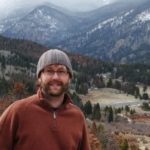 Dr. Josh Ritter is Assistant Director and Chaplain in the Department of Formation, Office of Spiritual Life, at Baylor University. He is Co-Leader of Baylor’s Public Deliberation Initiative and supervises all Cross Cultural Engagement programs in the Office of Spiritual Life. He is also Adjunct Faculty in the Baylor Interdisciplinary Core where he teaches World of Rhetoric.
Dr. Josh Ritter is Assistant Director and Chaplain in the Department of Formation, Office of Spiritual Life, at Baylor University. He is Co-Leader of Baylor’s Public Deliberation Initiative and supervises all Cross Cultural Engagement programs in the Office of Spiritual Life. He is also Adjunct Faculty in the Baylor Interdisciplinary Core where he teaches World of Rhetoric.
By Nicole Metts
Ever since I can remember, I have been making art and writing. For me, creating things gives me the balance I need to survive in this stressful world. I was an emotional teen, and my first marriage was a disaster, but poetry and painting got me through it. Everyone needs an outlet for emotion; even when you are content in your life. I know some people do not understand this, but for an artist, you must create because it is as important as breathing. It does not have to be an immaculate piece though, because the creating of the art is the satisfying part. Writing and visual arts also show your life history. Time goes by so fast. Will you remember these moments; these spiritual changes in yourself ten or twenty years from now without them? I even save the bad ones, because it is a learning process and growing process.
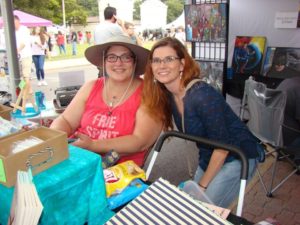
Jenuine Poetess and myself at Waco Cultural Art Fest. 2016
Last summer, I came across a submission for artists and poets in an art and word collaboration called “Ekphrasis.” I had never submitted any work of mine before, but I felt I needed to be brave and I sent it. Not long after, I received an email from Steve & Angie Veracruz of Central Texas Artist Collective about my poem. I was so excited I drove to Waco to meet them. We met at Tea 2 Go for Waco Poets Society open mic where I met Jenuine Poetess. I joined her group in poetry recital even though I was terrified and inexperienced. I certainly was not yet a master of confidence and rhythm like all the other amazing poets I heard that night. They were so supportive and it was wonderful to hear and speak with them. I was so inspired I decided I was going to start a writing group of my own. Jenuine told me she would be happy to give me guidance through the way and even come visit in the beginning if I needed help getting started for open mic. I drove home on cloud nine so excited about the upcoming Ekphrasis event and the idea of starting my own writing group with support.
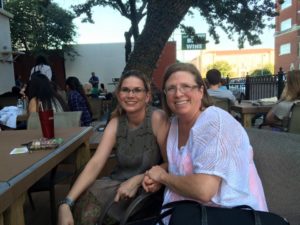
Dana Helms and I at the Waco Hipodrome
For the Ekphrasis exhibit artists and writers were paired together. I was paired with Dana Helms. She is a teacher, an animator and a fiber artist. We lived in different cities, but we had a lot of fun emailing each other. She created an amazing tapestry to match with my poem. Our relationship helped me build my confidence even more. I could not have been paired with a more amazing artist.
The Ekphasis pieces were hanging in the windows of businesses in downtown Waco for everyone to enjoy. My family and I admired each one, sipping old fashioned soda in glass bottles, and devouring sweets from the candy store. The main event was at the patio of the Hippodrome where some of the poets read their pieces with a copy of the artist’s work on an easel beside them; it was beautiful and professional. I finally met Dana Helms in person and we had a delightful conversation about art forms that interested both of us.
My Garden

Tapestry by Dana Helms
Tip toe amongst my Garden of Eden,
And you will find zeppelins amongst the clouds;
With acrobats hanging down and then,
Dancing dragons through the air and sounds
Music blowing through a band of trees
A lost fairy captured by the breeze
Lilies laughing from tickles of the bees
Burrowing deep inside entrails touching hearts and seeds
Through the aroma mist of storm and seas
Intoxicated in bliss and ease
I watch the sun and moon taunt and tease
The jealous shooting stars that fail to seize
A pinnacle above wonderland plain to be
Found only by elite and obscure who believe
There is more to life than what can be seen.
Waco is getting ready to have another Ekphrasis event soon . If this sounds like fun then maybe you could get involved or follow Central Texas Artist Collective or Waco’s Poets Society to enjoy their happenings. Both groups are active in the community and are always up to something.
I have always loved the arts and believe it is essential part of our culture. If you think about it; what would your city be like without art? No live music, film, dance, poetry, murals, museums, theater, sculpture, local art, and art focused events? Even the buildings, bridges, and landscaping are art. Waco has grown so much over the years and I can certainly see why. The right people are in place getting people excited about their community.
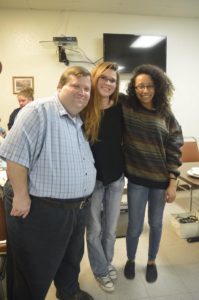
My Team David and Briann
Now I am thrilled to tell you that I have started a group called Central Texas Writing Society. It was hard finding members at first. I started with hanging flyers and talking to the library about having meetings there. With the help from the library director Kevin Marsh, my first dedicated writer and now VP of CTWS David Hardin, my friend Briann Gonzalez (our tech guru), and the local Five Hills Art Guild supporting us on first Friday at Frames & Things in Copperas Cove, we are growing. My city has a long way to go to catch up to the community involvement of Waco, but I am determined to be part of the driving force to get them there.

Our first open mic January 2017 at Lil Tex in Copperas Cove.
I invite you into our group or into one in your community — get involved! I have met many amazing people, and they have been encouraging and full of wisdom. I cannot imagine living life without them now. Surround yourself with people with similar interests, and they can inspire you and help you grow in whatever it is you love. If you do not think that is your “cup of tea” I hope you support the arts and community groups in your own way because that is just as important. I am still a strong believer that art and word can change the world! It has certainly changed my world.
Get Involved!
To learn more about and to register for the 2017 EKPHRASIS Waco! Exhibit, please visit the CTAC Call for Artists page here. All call for participants is open now through June 2, 2017.
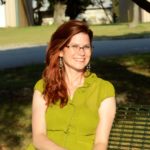 Nicole Metts is the founder of Central Texas Writers Society in Copperas Cove. She has been passionate about the arts since childhood. Besides being a poet, she is a painter, photographer, and enjoys exploring other medias as well. Currently; she is a full-time student at Central Texas College with plans to transfer soon to Texas A&M to achieve a B.A. in English with a minor in art. She also works full time as a supervisor, is happily married, and has two children. You can connect with her at https://www.facebook.com/CentralTexasWritersSociety/ or [email protected].
Nicole Metts is the founder of Central Texas Writers Society in Copperas Cove. She has been passionate about the arts since childhood. Besides being a poet, she is a painter, photographer, and enjoys exploring other medias as well. Currently; she is a full-time student at Central Texas College with plans to transfer soon to Texas A&M to achieve a B.A. in English with a minor in art. She also works full time as a supervisor, is happily married, and has two children. You can connect with her at https://www.facebook.com/CentralTexasWritersSociety/ or [email protected].
By Melissa Mullins
Have you heard of “citizen science”? Different definitions for this term exist but they typically say something like: “Citizen science is scientific work undertaken by members of the general public, often in collaboration with or under the direction of professional scientists and scientific institutions” or one I like “projects in which volunteers partner with scientists to answer real-world questions” (Cornell Lab of Ornithology, a leader in citizen science). Even if you didn’t call it citizen science, you probably know someone (maybe you) who has participated in a citizen science project.
Although the term citizen science is relatively new, amateur scientists (who may have had no formal training in science) have contributed to scientific discovery throughout history, and continue to do so today. They do so because of a love of knowledge and a desire to learn about the natural world. In fact, many great early scientists had other occupations and science was something they pursued in their leisure time. Today, many professional scientists “crowdsource” data collection to help them accomplish tasks that otherwise might be difficult or impossible.
Citizen science has been practiced in Waco since at least 1957 through people participating in the annual Audubon Society Christmas Bird Count, which this year entered its 117th year. Researchers have used data from the Christmas Bird Counts in over 200 peer-reviewed papers to answer questions about bird community ecology, distribution and population dynamics. This year I participated in one of the two counts held locally, and it was great fun. No experience necessary!
Both the City of Waco and Baylor University support the Texas Stream Team which has trained citizen science water quality monitors around the state for over 25 years. The City provides kits and resources for volunteers concentrated on monitoring sites in the streams and rivers that feed Lake Waco, our source of drinking water, and Baylor students monitor sites around the Baylor campus. The data is entered into a statewide database that is accessible to all.
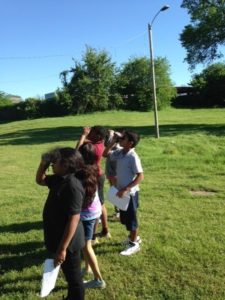 Participation in citizen science is not limited to adults! This spring, students at Indian Spring Middle School and Dewey Recreation Center began participating in Science Action Clubs, Birds in Your Schoolyard. They are learning about birds weekly and collecting bird counts which will be entered into the Ebird database. The Cameron Park Zoo is also hosting this program. On World Water Day March 22, 300 8th graders at Cesar Chavez Middle School measured water quality from the Brazos River, Waco Creek, and Lake Waco and their data will be entered into the EarthEcho Water Monitoring Challenge database.
Participation in citizen science is not limited to adults! This spring, students at Indian Spring Middle School and Dewey Recreation Center began participating in Science Action Clubs, Birds in Your Schoolyard. They are learning about birds weekly and collecting bird counts which will be entered into the Ebird database. The Cameron Park Zoo is also hosting this program. On World Water Day March 22, 300 8th graders at Cesar Chavez Middle School measured water quality from the Brazos River, Waco Creek, and Lake Waco and their data will be entered into the EarthEcho Water Monitoring Challenge database.
Citizen science is a great way for people, regardless of age, background or education, to be more involved in scientific endeavors that interest them. Science benefits all of society, and the cost to fund scientific research is largely borne by the public, but those involved directly in scientific research have often been a fairly narrow swath of society. Now more than ever in the face of a changing climate (both literally and politically) science can use champions among the public. Will you be one?
Want to participate or learn more?
- Consider becoming a Waco area Texas Master Naturalist http://txmn.org/heartoftexas/
- Participate in Waco area Christmas Bird Counts http://www.centexaudubon.org/
- Join Texas Stream Team http://www.meadowscenter.txstate.edu/Service/TexasStreamTeam.html
- Start a Science Action Club http://www.calacademy.org/science-action-club-sac
- Participate in the EarthEcho Water Monitoring Challenge http://www.worldwatermonitoringday.org/
To learn more about the diversity of citizen science projects that may interest you, try visiting sites like scistarter.com or citizensciencealliance.org.
 Melissa Mullins is an aquatic scientist who coordinates education and outreach at Baylor’s Center for Reservoir and Aquatic Systems Research. She is a Baylor alum (M.S. Environmental Biology ’95) and is on the Board of the Informal Science Education Association of Texas which focuses on promoting science learning outside the classroom. She loves goats and yoga and recently visited the Nile River in Uganda as part of a Baylor trip. She believes that a vibrant scientific community that includes the public in its work is a fundamental underpinning of a democratic society.
Melissa Mullins is an aquatic scientist who coordinates education and outreach at Baylor’s Center for Reservoir and Aquatic Systems Research. She is a Baylor alum (M.S. Environmental Biology ’95) and is on the Board of the Informal Science Education Association of Texas which focuses on promoting science learning outside the classroom. She loves goats and yoga and recently visited the Nile River in Uganda as part of a Baylor trip. She believes that a vibrant scientific community that includes the public in its work is a fundamental underpinning of a democratic society.
By Ashley Bean Thornton
I was visiting with my friend Austin Meek (host of the fantastic KWBU program Downtown Depot) the other day and he asked me, “What’s the best thing happening at Baylor right now?” Wow! So much to choose from…we just named our first woman president, who by all accounts will be a super-star. We’re about to graduate another stellar class of brand new Baylor alums off to make the world a better place in all kinds of ways we can’t even imagine yet. Baylor researchers are making new discoveries about everything from the effects of algae in the water supply, to how to detect eye cancer, to how to teach number sense to pre-k kids. I couldn’t pick the BEST thing, so I slyly answered a slightly different question: What’s MY FAVORITE thing happening at Baylor right now?
Before I reveal my answer, I want to take a little detour to consider the purpose of higher education.
College tuition is going up. Student debt is increasing. Some people are starting to wonder if a college education is “worth it” in terms of increasing lifetime earning potential. On another front, technology is making it easier and easier to “deliver content” in all kinds of convenient ways – perhaps much more convenient than sitting in classes for four years… I do not know what the future holds for higher education, but it will almost certainly include some big changes. The aggravating thing about change is that it is almost always disruptive and stressful. The good thing about change, though, is that it pushes us to circle around and think about core purposes and what we are really trying to accomplish.
What, then, is the purpose of higher education? One purpose is certainly to help people prepare for a career – a good job with good pay. No argument there. Just as certainly though, that is not the only purpose. To me the “higher” in higher education, in the USA at least, is educating the citizenry of a democracy to govern themselves wisely and well.
Where do we learn to wrestle with the big questions of “truth, beauty and justice?” Where do we learn to think about what kind of world we want to create together? Where do we learn the skills of how to work together to create that world? Where do we learn to listen and to present a reasoned argument instead of just yelling at each other? Where do we learn to have some empathy for our fellow humans even when we disagree with them? Where do we learn to discuss difficult issues in a productive way? Where do we learn to leaven our zeal for efficiency, productivity and profit with an understanding of the roles of diversity, creativity and compassion?
I don’t think we can run a democracy without citizens with this kind of knowledge and skill, and I don’t think we can take for granted that people will develop it on their own. This kind of learning and thinking is the journey of a lifetime. I think it is a core purpose of higher education to equip people for that journey and to give them a good running start on their way. As the form of higher education evolves, I don’t want this purpose to get lost along the way. I want our institutions of higher ed, Baylor included, to be as creative in thinking of ways to fulfill this purpose as we are in thinking of ways to help students get the skills they need for a career.
That brings me to a terrific program that has taken root at Baylor this last year. It’s called The Baylor Public Deliberation Initiative, “PDI” for short. PDI’s work is to “invite Baylor students, staff, and faculty as well as local community members to participate in forums about local and national issues to better understand the perspectives, possible outcomes, and trade-offs of different options.” In other words, they set up workshops where we can practice doing democracy together. They invite not only Baylor students, but also the Waco community to participate, because part of what it means to do democracy is to do it with all kinds of different people from different stages of life, different walks of life and different life experiences.
The PDI folks have already facilitated deliberations on topics like Immigration, Campus Carry, and Climate Change. At each deliberation participants share personal connections to the issue, have a civil discussion about the pros and cons of at least three different approaches to the issue, and then deliberate about what actions they believe they could agree to take despite differences in perspective. Doesn’t that sound like a terrific way to do democracy together?
 As an extension of this work, PDI is hosting a “Civic Life Summit” that is open to the public. On June 1 & 2, the summit will offer practical sessions designed to help us learn the skills of citizenship. Topics include “Living Room Conversations on Race,” “Beyond Reactions and Factions: A Pragmatic Approach,” “GRIT 101: Getting Gritty Doing Civic Engagement,” and many more. The sessions will be led mostly by active Waco community members (including some Baylor faculty and staff) with a sprinkling of experts brought in from other communities. Registration is $95 until May 15, and a few scholarships are still available.
As an extension of this work, PDI is hosting a “Civic Life Summit” that is open to the public. On June 1 & 2, the summit will offer practical sessions designed to help us learn the skills of citizenship. Topics include “Living Room Conversations on Race,” “Beyond Reactions and Factions: A Pragmatic Approach,” “GRIT 101: Getting Gritty Doing Civic Engagement,” and many more. The sessions will be led mostly by active Waco community members (including some Baylor faculty and staff) with a sprinkling of experts brought in from other communities. Registration is $95 until May 15, and a few scholarships are still available.
I love that my Alma Mater is hosting an event that focuses on civic learning, an event that invites students and the rest of us in the community to learn to be better citizens together. Is it the best thing happening at Baylor right now? Not sure…it has lots of competition. But, it is my favorite! Hope to see you there. It’s more fun to learn to be better citizens together!
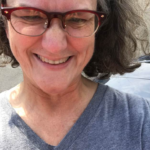 This Act Locally Waco blog post is by Ashley Bean Thornton, she works at Baylor, and helps out with Act locally Waco. She likes to walk. If you see her, honk and wave and say “hi!”
This Act Locally Waco blog post is by Ashley Bean Thornton, she works at Baylor, and helps out with Act locally Waco. She likes to walk. If you see her, honk and wave and say “hi!”
The Act Locally Waco blog publishes posts with a connection to these aspirations for Waco. If you are interested in writing for the Act Locally Waco Blog, please email [email protected] for more information.
By Elizabeth Ligawa
We wear the mask that grins and lies,
It hides our cheeks and shades our eyes-
This debt we pay to human guile;
With torn and bleeding hearts we smile
— Excerpt from Paul Laurence Dunbar’s poem, “We Wear the Mask”
We wear the mask the grins and lies
The last time I was asked the question, “How are you?” was last night at H-E-B. I usually splurge on late night errands when I have a child-free night, and I was taking full advantage of the late operating hours. Before my visit to the store, I had just finished up a painful conversation with a friend going through a very difficult time. My heart was heavy. My mind was still trying to wrap itself around the traumatic experiences that were shared with me. My spirit was low. The inquiry came as I was placing my items for purchase on the conveyor belt, still in the fog of my previous conversation: “How are you?,” the cashier asked. My response was a polite, socially acceptable lie: “I’m doing just fine, thank you. And you?”
In situations like this one (being in line at the grocery store to be exact), we are usually not expected to engage in deep conversations about life, or suffering, or innovative approaches to a long-standing challenge in our community. No one is expected to describe Anselm’s ontological argument in the bread aisle next to the pickles, or to participate in a solution that will protect our most vulnerable residents. But, if you wanted to have a meaningful conversation around a difficult topic, where would you go?
It hides our cheeks and shades our eyes
In the last several months, I have been approached by a growing number of faith and community leaders who are genuinely seeking guidance on techniques and strategies of engaging people around one of these difficult topics: race. When it happens, I am always honored by this inquiry because of the risk involved in the asking. Waco is a very interesting place when it comes to race, and I am finding out more and more that while we see it, we usually do not know where to go with this conversation? Do we talk about our community’s history, and its contributions to how race plays out with regard to outcomes and opportunities? Are we seeking to understand the missing racial diversity in our congregations, or among other community institutions? Do we share in our understanding of the implications of race?
In topics like race, where we may not feel confident in our navigation skills, we follow similar patterns of dialogue that resemble my engagement level with the cashier at HEB: we politely wear our mask. We politely decline the opportunity to meaningfully engage.
This debt we pay to human guile; With torn and bleeding hearts we smile
To be clear, I am not promoting the idea that we should share the questions of our hearts with the cashiers at H-E-B, or the baristas at Starbucks, or even the person sitting next to you as you’re reading this post. What I am saying is that a community functions much in the same way as an individual. And as a community practitioner, I am particularly interested in how you (as a community) are having these conversations about what impacts you. How do you feel about the local impact of federal policies? What are you doing with the questions that you are not sure are welcome in polite company? How are you dealing with issues concerning race and your organization, or community?
There is a way to have these conversations well, and it is as easy and accessible as having different modes of facilitation as part of your tool belt. On June1-2, the Public Deliberation Initiative will be hosting its inaugural “Civic Life Summit: Doing Democracy Differently”. At this summit, you will learn how to: 1) Build mutual respect and understanding across race, religion, and more; 2) Move beyond divisiveness to work together for greater good; 3) Identify common ground across difference, and potential steps forward together, and 4) and Develop a framework for public engagement within your group or sphere of influence. To register for the Summit, please click here. The cost is $95 per individual with limited scholarships available. For more information, please contact Erin Payseur by sending an email to [email protected].
We can embrace conversations with courage. We can bring confidence in engaging these challenging topics. We can produce change. But first, let’s talk.
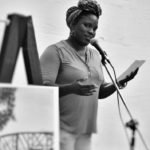 Elizabeth Ligawa is a recent graduate from Truett Theological Seminary, and the Diana R. Garland School of Social Work, earning both her Master of Divinity, and Master of Social Work. Though her prized role is being a mother to her dear son, Elijah, Liz has a love for encouraging people to come together in ways that engender healthy communities. Her role as the Director of Community Engagement at Prosper Waco allows her the room to work in and among the many faces of her beloved Waco community. She may be reached at [email protected].
Elizabeth Ligawa is a recent graduate from Truett Theological Seminary, and the Diana R. Garland School of Social Work, earning both her Master of Divinity, and Master of Social Work. Though her prized role is being a mother to her dear son, Elijah, Liz has a love for encouraging people to come together in ways that engender healthy communities. Her role as the Director of Community Engagement at Prosper Waco allows her the room to work in and among the many faces of her beloved Waco community. She may be reached at [email protected].
The Act Locally Waco blog publishes posts with a connection to these Aspirations for Waco. If you are interested in writing for the Act Locally Waco Blog, please email [email protected] for more information.
By Madison Albee
Summer is the perfect time to have unique experiences and learn something new. MCC Continuing Education is committed to the development and enrichment of Waco and McLennan County. Our continuing education programs are designed to help individuals grow, explore their interests, develop their skills, or help them shift careers. Check out what we have to offer!
Community Programs
There are many different kinds of classes that are open to the Waco and McLennan County community, including but not limited to:
- Arts & Hobbies
- Culinary
- Fitness and Wellness
- Languages
- Travel & Special Events
- Kids College
Classes range from “House Flipping 101” to “Country Western Dance.” You are guaranteed to find a class that interests you, and even something that interests the kids! MCC Kids College offers classes such as “Babysitter Basic Boot Camp” and “Minecraft: Travel to the Future.”
Corporate Training and Workforce Education
For those interested in further developing their skills or wanting to shift their careers, MCC offers corporate training and workforce education over the summer with classes in the following areas:
- Auctioneering
- Computers
- Professional Development
- Law Enforcement
- Telecommunications
- Teacher Certification
- Truck Driver
Online courses are also available for corporate training and workforce education.
Health and Human Services
If you have always had an interest in the health and medical field, this summer is the perfect time to start your journey at MCC. We offer classes for those wanting to pursue positions such as:
- Activity Director
- EKG Technician
- Nurse Aid/Medical Assistant
- Massage Therapist
- Pharmacy Technician
- Personal Trainer
- Medical Coding Specialist
Some health and human services courses have entrance requirements such as immunizations and background checks. For more information, please call 254-299-8590.
Highlander Ranch
MCC’s Highlander Ranch offers some summer activities for members of the community interested in horses, horseback riding, and spending time outdoors.
- Clinics
- Pony Club
- Horse Shows
For more information about Highlander Ranch please visit www.mclennan.edu/highlander-ranch.
To see ALL the classes MCC Continuing Education will offer this summer, please take a look at our online brochure.
A summer spent with MCC Continuing Education will be a summer well spent. Register now before classes fill up!
Online: Go to our home page at www.MCCandYOU.com and click on How to Register.
In person: Register at the Continuing Education Office. Office hours are 8 a.m. – 6 p.m. Monday – Thursday and 8 a.m. – 5 p.m. Friday.
Phone: Call 254-299-8888 from 8 a.m. – 6 p.m. Monday – Thursday and 8 a.m. – 5 p.m. Friday. Payment must be made by American Express, Discover, MasterCard or Visa.
MCC hopes you have a sunny and educational summer!
 Madison Albee is a senior at Baylor University from Fort Worth, Texas. She is studying journalism/public relations with a concentration in marketing and is graduating this coming May. Currently Madison works for MCC as a public relations intern in the marketing and communications department. She is also the public relations assistant for Luca Magazine.
Madison Albee is a senior at Baylor University from Fort Worth, Texas. She is studying journalism/public relations with a concentration in marketing and is graduating this coming May. Currently Madison works for MCC as a public relations intern in the marketing and communications department. She is also the public relations assistant for Luca Magazine.
The Act Locally Waco blog publishes posts with a connection to these aspirations for Waco. If you are interested in writing for the Act Locally Waco Blog, please email [email protected] for more information.
By Russell Ritchey
We moved to Waco in 1990 and raised four beautiful children born and raised on what to me is now hallowed ground. My wife, Angie, passed away last year, God rest her soul. But she poured her heart and soul into our kids. It was so beautiful. (She was actually born in Waco in 1964, her dad, Ira Thompsom, being a Methodist Minister at that time). I penned a poem (actually a song) in 2003 as I pondered the ways of God, and life, as I listened to the cicadas in the lone oak tree above, and in Cameron Park all around, cradling my newborn son, Wesley, in my arms, nicknamed then as ‘Bug’. So now, after all these years, I want to share how the summer sound of the cicada has impressed upon me a strong and enduring memory. I hope you find my poem (song) a pleasant and pleasurable read and that it will compliment the melody of the cicada bug in your Waco trees this summer, and all the summers to come, and ultimately, in your many memories.
Here’s to my children, and especially my ‘bug’, and to my late wife Angie.
————
That Cicada Summer Love Song
Cicada, cicada, singing that summer song,
Cicada, cicada, singing all summer long.
The sound of summer fills the air,
Gently soothing every care.
Cicada, cicada.
The sun is shining bright outside,
It’s wonderful to be alive.
And now and then there is a breeze,
Whispering sweet memories.
Cicada, cicada.
So many summers from the past,
Oh how I wished each one would last
Just like this moment here with you,
I hope it is a memory too.
Cicada, cicada.
As summers come and summers go,
I hope your love for me will grow.
And when you hear them in the tree,
I hope you will remember me.
Cicada, cicada.
The sound of summer fills the air,
Gently soothing every care.
Cicada, cicada …
———–
Tempo: Grave – very slow (25–45 bpm) Just like the ‘dog days of summer’.
Use a guttural vibrato on the ‘ca’ in ci-ca-da using the vibrations of the epiglottis. Hold ca——- for about three seconds (like gargling with water but with air instead) to emulate the sound of the cicada. Pitch goes from low to a little higher to fading out (just like the sound of the cicada).
Interestingly, Cicadas have a two to seventeen year life cycle, depending on the species. Their familiar sounds during the ‘dog-days’ of summer are sometimes pleasant, sometimes annoying (depending on your frame of mind). However, the cicada’s time in life is as brief as a midsummer’s night, and it comes and goes before you know it.
Just like the wondrous moments of youth, which swiftly pass along, and then are gently locked away in the never changing realm known only as memories. May it forever be that we only have pleasant ones, and all that may be otherwise be gently washed away by the sound of the cicada.
 Russell Ritchey may not be a native son of Waco Texas, but how close can you get? His wife, Angie, of 27 years (God rest her soul) was born in Waco, 1964. And their four children, Nathan, Le’Anna, Kristina, and Wesley all breathed their first air in the Heart of Waco on Texas soil. Russell took a job at L-3 in 1990 (then Chrysler Technologies) and has enjoyed his home in Waco ever since, and his family that brought him there, and his job at L-3 that made it possible.
Russell Ritchey may not be a native son of Waco Texas, but how close can you get? His wife, Angie, of 27 years (God rest her soul) was born in Waco, 1964. And their four children, Nathan, Le’Anna, Kristina, and Wesley all breathed their first air in the Heart of Waco on Texas soil. Russell took a job at L-3 in 1990 (then Chrysler Technologies) and has enjoyed his home in Waco ever since, and his family that brought him there, and his job at L-3 that made it possible.
The Act Locally Waco blog publishes posts with a connection to these Aspirations for Waco. If you are interested in writing for the Act Locally Waco Blog, please email [email protected] for more information.
By Jennifer Alumbaugh
The integration of creative process with therapy has been a long tradition in the mental health field. It is used to “explore feelings, reconcile emotional conflicts, foster self-awareness, manage behaviors, addictions, and coping, develop social skills, improve reality orientation, reduce anxiety, and increase self esteem,” according to the American Art Therapy Association, “the goal in art therapy is to improve or restore a client’s functioning and their sense of personal well-being.” The creative process using visual arts of writing, painting, drawing, sculpture, mixed media, music, and other expressions, allow people to connect with their subconscious and to other parts of themselves beyond where language can take us. For some people who experienced trauma at pre-verbal stages of development, or during a time when they were learning their first language, but now only speak a second language, engaging in a visual process facilitates that connection to feelings and experiences for which a person may not have language.

(Original mixed media canvas by Jennifer Alumbaugh, LMFT)
The physical act of creating, using our hands to make, to shape, to move a medium around a page or a canvas or a block of clay, also connects us to different levels of our selves which allows for insights, awareness, and coping that is accessible beyond traditional “talk therapy.” In working with couples and families, creative process engages people to complete tasks, to work cooperatively, to see glimpses of the other’s thoughts and experience in fresh ways that can move a couple or family through conflict, through grief, through challenges, through communication toward a place of healing and wholeness.
When I consider the realm of mental health, I gather into that the following experiences: mental illness, grief and loss, and trauma recovery. Because while grief is not a mental illness, the experience of loss can result in mental health concerns. And while having survived a trauma incident or complex trauma is not a mental illness, the resulting PTSD, cPTSD, and other diagnoses are mental health issues. One of the things I love about using creative process in session with clients, is how art can help disrupt patterns of automatic thinking and can boost a client up out of a rut. Sometimes we create a visual representation of the emotion they are most struggling with: fear, sadness, anxiety, grief, anger. Sometimes it looks like a monster; sometimes it is a looming shadow; sometimes it is a silly creature that makes a client laugh instead of being afraid; sometimes they are small, pocket-sized beasts; sometimes they are great larger-than-life manifestations.
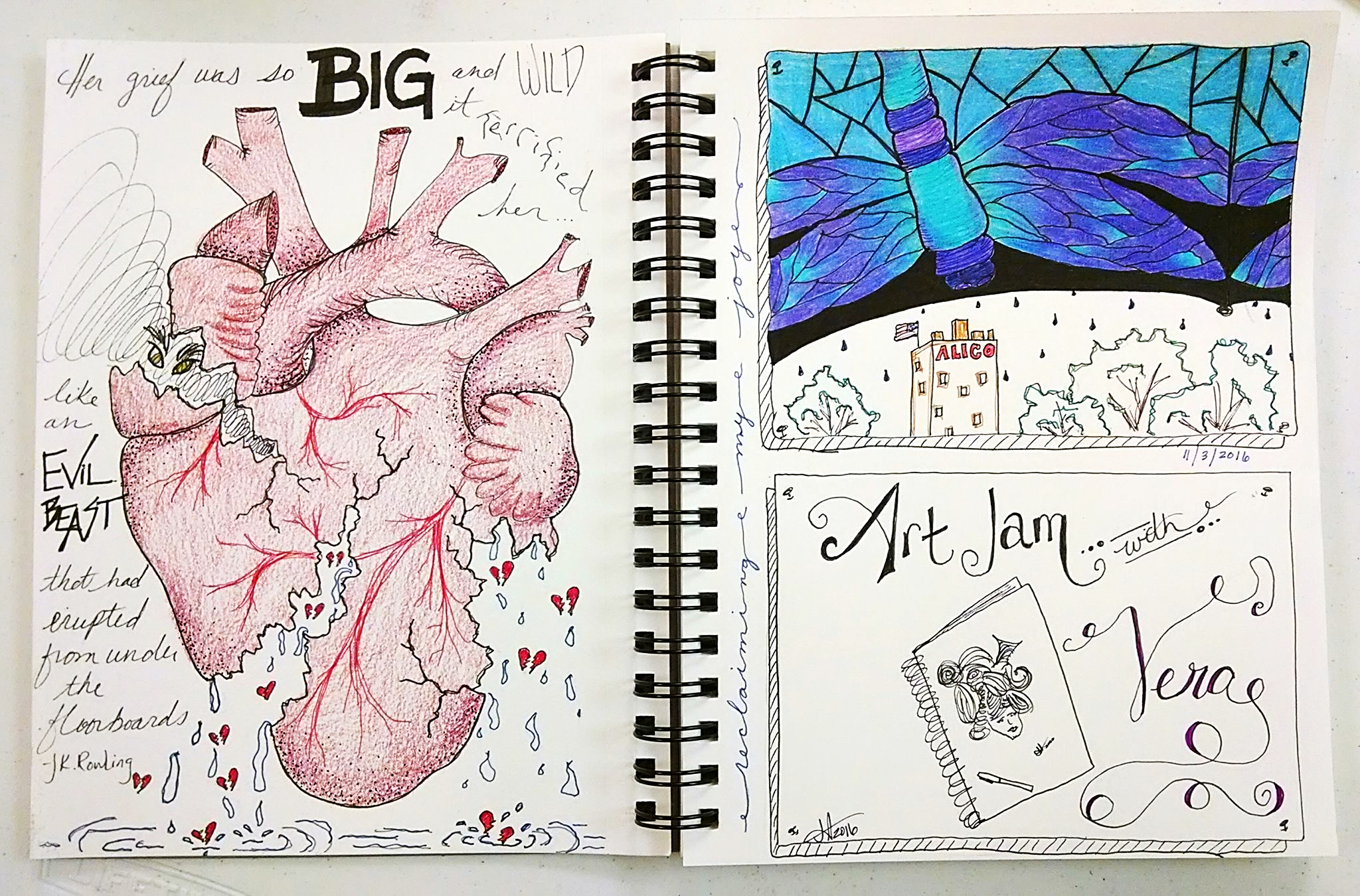
(Original mixed media drawing by Jennifer Alumbaugh, LMFT; quote by J.K. Rowling)
Naming those feelings—actual people names—and creating a visual image of them, helps to externalize the process. For me, grief is Harold and depression is Gertrude. They show up often, like uninvited guests, and over stay their welcome! But when I create caricatures out of these feelings, and create goofy personas to go with them, it shifts the power balance and gives me the chance to call the shots—to decide whether or not I let them in, or how long they get to stay. It is the same for clients. When we name and externalize our struggles, it separates them from us—so we are not afraid, fear is visiting us. We are not depressed; depression crashed our party. We are not anxiety; anxiety interrupted our meeting. Art gives us the tools to create a tangible, concrete representation of that with which we are coping bringing it out of the abstract and into the finite. Once we accomplish that, then we can feel more empowered to cope, manage, and control our feelings and experiences.
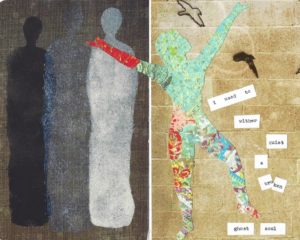
Original mixed media artwork and poem by Jennifer Alumbaugh, LMFT, 2016
There are many people who engage in creative expression outside of the context of a therapy session and who find that process to be therapeutic. There is something deeply satisfying about creating with our own two hands. For many, the act of creating is a soothing, meditative, practice. For me, I call it a “mind vacation,” because when I am making art, that is the only thing my mind is thinking about. I feel joy. I feel peace. I feel delight. Even when I mess up—which is often, I appreciate my process and everything I learn along the way.
I’ve been a poet and spoken-word artist for a long time and I found incredible release in exploring my grief, depression, and trauma recovery, through the medium of poetry. But I have found that the process is twofold—there is the creating, and then there is the sharing. I found that it wasn’t enough to create for myself and by myself and that as I began to share my work with others, I found this extraordinary, medicinal “me too.” Sharing my creative expression, my interpretation, my attempts to make meaning out of my experiences, it connected me with others who had also survived, struggled, and coped with similar things. I learned that I am not alone. And I learned that my creative expressions give others permission to feel and to question and to work through their own experiences. I realized that when we share our process of healing, coping, recovering, with others, there is no place for shame to grow and fester. Alongside all of the therapy work I was doing, sharing and listening and seeing others’ creative process moved me along the healing path as well.

(Original mixed media collage and poem by Jennifer Alumbaugh, LMFT)
Waco has a unique opportunity to engage, as a community, in creative process exploring the intersections of heart, mind, body, and soul in the upcoming Central Texas Artist Collective (CTAC) EKPHRASIS Exhibit. The call for artists will open May 1-31st and will invite both visual artists and poets to enter to be paired with a buddy—visual artists with poets and poets with visual artists. Each duo will then have 4 months to collaborate creating a visual piece and a poem which will be displayed together in shop windows along Austin Avenue and other downtown areas opening on the 1st Friday in November 2017. The theme for each creative pair will be to explore mental health, grief and loss, and/or trauma recovery. This will be a powerful experience in the process, in the exhibit, and in the viewing. The goal is to bring many stigmatized realities to light, normalize mental health experiences, and empower one another in our coping. For complete details on how to enter EKPHRASIS Waco! please visit the CTAC information page here.
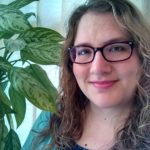 Jennifer Alumbaugh, MS is a Licensed Marriage and Family Therapist providing clinical and professional development consultation services at Enrichment Training and Counseling Solutions. She has extensive experience working with adolescent and adult survivors of psychological and spiritual abuse, trauma (sexual violence, childhood trauma, interpersonal violence); and complex PTSD. These, along with grief and loss work are her areas of specialization. Jennifer practiced as a mental health clinician throughout Los Angeles County working with children, youth, and their families from 2007-2012. In Central Texas, Jennifer has worked as a Site Coordinator with Communities in Schools of The Heart of Texas at G.W. Carver Middle School; as an independent consultant and professional development trainer; and conference speaker. In 2016 Jennifer created an implemented a therapeutic creative writing program, Brave Young Voices, at Klaras Center for Families and at the Texas Juvenile Justice Department correctional campus at Mart, TX. She may be reached at: [email protected] or 254-405-2496.
Jennifer Alumbaugh, MS is a Licensed Marriage and Family Therapist providing clinical and professional development consultation services at Enrichment Training and Counseling Solutions. She has extensive experience working with adolescent and adult survivors of psychological and spiritual abuse, trauma (sexual violence, childhood trauma, interpersonal violence); and complex PTSD. These, along with grief and loss work are her areas of specialization. Jennifer practiced as a mental health clinician throughout Los Angeles County working with children, youth, and their families from 2007-2012. In Central Texas, Jennifer has worked as a Site Coordinator with Communities in Schools of The Heart of Texas at G.W. Carver Middle School; as an independent consultant and professional development trainer; and conference speaker. In 2016 Jennifer created an implemented a therapeutic creative writing program, Brave Young Voices, at Klaras Center for Families and at the Texas Juvenile Justice Department correctional campus at Mart, TX. She may be reached at: [email protected] or 254-405-2496.
The Act Locally Waco blog publishes posts with a connection to these Aspirations for Waco. If you are interested in writing for the Act Locally Waco Blog, please email [email protected] for more information.
By Robin Wilson
Students enrolled in the Advancement Via Individual Determination (AVID) classes in Waco Independent School District (ISD) have increased over 200%! In the school year 2014-2015 just fewer than 400 students were enrolled in the Waco ISD AVID classes. The current school year has AVID enrollment over 800 students in the 7th -12th grade classrooms.
What is an AVID classroom?
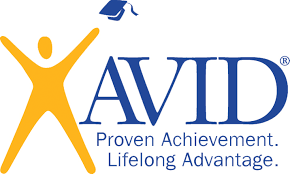 The AVID classroom focuses on developing students’ critical thinking, literacy, and math skills in all content areas. Academic behaviors, including organization, time management, and goal setting, are also taught as part of the AVID System. The goal of AVID is to develop and strengthen these skills and to empower students to take responsibility for their own learning and to close the achievement gap by preparing all students for college and other postsecondary opportunities. It assists students in developing confidence and encourages them to take academic risks. AVID provides a personalized learning environment that focuses on individual needs and creates opportunities for students to develop meaningful social networks and relationships. The AVID elective class also provides test-taking skills, assistance in preparing for and completing the college application process, and cooperative study/tutoring groups.
The AVID classroom focuses on developing students’ critical thinking, literacy, and math skills in all content areas. Academic behaviors, including organization, time management, and goal setting, are also taught as part of the AVID System. The goal of AVID is to develop and strengthen these skills and to empower students to take responsibility for their own learning and to close the achievement gap by preparing all students for college and other postsecondary opportunities. It assists students in developing confidence and encourages them to take academic risks. AVID provides a personalized learning environment that focuses on individual needs and creates opportunities for students to develop meaningful social networks and relationships. The AVID elective class also provides test-taking skills, assistance in preparing for and completing the college application process, and cooperative study/tutoring groups.
AVID Elementary
Waco ISD offers AVID at each of the middle school and high school campuses. AVID has also extended to four of the WISD elementary campuses. What does AVID look like at the elementary campus? AVID elementary is campus-wide initiative with a focus on developing organizational skills for all students, instilling student success skills, creating a college going culture, inspiring belief in academic rigor and success, providing professional development for teachers, and providing students a smoother transition to the next school.
Waco ISD AVID student accomplishments
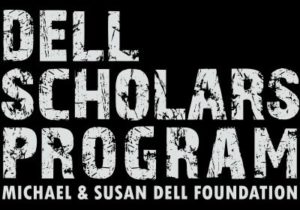 The Dell Scholars program, an initiative of the Michael & Susan Dell Foundation, recognizes students who have overcome significant obstacles to pursue their educations. Waco ISD is proud to announce three winners and two of the students are AVID students. Dell Scholars receive $20,000 each to complete their higher education over the course of six years. Each student is also provided technology, a private scholar networking community, resources, and mentoring to ensure they have the support needed to achieve their college degrees.
The Dell Scholars program, an initiative of the Michael & Susan Dell Foundation, recognizes students who have overcome significant obstacles to pursue their educations. Waco ISD is proud to announce three winners and two of the students are AVID students. Dell Scholars receive $20,000 each to complete their higher education over the course of six years. Each student is also provided technology, a private scholar networking community, resources, and mentoring to ensure they have the support needed to achieve their college degrees.

- University High School AVID student and Dell Scholar Winner – Sammy Ortega Rangel; future college: Texas A&M
- University High School student and Dell Scholar Winner – Alexandra Castillo; future college: University of Texas at Arlington
- Waco High School AVID student and Dell Scholar Winner – Khristian Allen; future college: University of Texas
Other Waco ISD Student Accomplishments:
- Over 90% of the Waco High AVID Seniors were accepted to 4-year universities in the school year ending June 2016. June 2017 will be the first AVID Senior class for University High School.
- Increased enrollment of AVID students in advanced placement or dual-credit courses from 2014-2015 to the current school year.
- Increased grade point average (GPA) for AVID students after enrolling in the AVID class.
- AVID students out perform non-AVID students on all state assessments for the 2015-2016 school year.
AVID Professional Development for Teachers
AVID has not only been a great success story for our students but has provided meaningful, research-based instructional professional development for teachers. AVID professional development emphasizes the training of teachers and other school professionals in the use of specific instructional strategies focused on writing, inquiry, collaboration, and reading. These strategies are taught in a three-day summer conference or through additional trainings. Campuses provide additional AVID professional development throughout the school year led by the AVID district director, campus coordinator, elective teacher and/or teachers who attended summer institute.
Last summer Waco ISD had over 100 teachers attend the AVID Summer Institute Conference in San Antonio. This year there will be over 120 teachers attending the AVID Summer conference.
AVID School-wide
Waco ISD AVID provides a structure to close the achievement gap that exists between groups of students. The WISD AVID elective class provides a school-based network that not only supports academic development but also provides information about issues directly related to postsecondary education. Although the AVID elective class only serves 10-15% of the campus population, the goal is to provide all students access to the core AVID concepts such as organizational and study skills, enrichment and motivational activities, and college preparation through the implementation of AVID school-wide.
Think you might be interested in working with AVID students? – Each year we hire individuals to be AVID tutors to work with our middle school and high school students. Starting salary is $12.50 an hour for college students and up to $22 for retired teachers. Hours are flexible. Recruitment for the 2017-2018 AVID tutors begins June 1, 2017. If interested, please email Robin Wilson at [email protected].
 Robin Wilson is currently completing her third year as the AVID District Director for Waco ISD. Before becoming the AVID District Director, she served as a campus principal in the district for eight years. She is also currently a third year PhD student at Baylor University in the Educational Psychology Department. Her focus is college readiness and child development. She plans to graduate in May 2018.
Robin Wilson is currently completing her third year as the AVID District Director for Waco ISD. Before becoming the AVID District Director, she served as a campus principal in the district for eight years. She is also currently a third year PhD student at Baylor University in the Educational Psychology Department. Her focus is college readiness and child development. She plans to graduate in May 2018.
The Act Locally Waco blog publishes posts with a connection to these aspirations for Waco. If you are interested in writing for the Act Locally Waco Blog, please email [email protected] for more information.
By Melody McDermitt
Please don’t stop bringing Meals on Wheels to me… I’m not sure how I will make it without you,” has been the most common call we have received since the media attention focused on Meals on Wheels funding. We are reassuring our clients that their meal service will continue and making sure our donors and volunteers know how important they are to our ability to serve.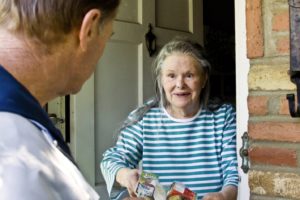
For fifty years our agency has served the community’s most vulnerable populations and because of our strong community support, we will be here to continue caring for the people of Waco, McLennan, Hill and Falls Counties.
Below is information about our budget, program, and how you can help:
- We receive approximately 45% of our funding from federal and state sources. Most of the funds are through the Older Americans Act, administered by the US Department of Health and Human Services. We match these funds with private dollars to serve people meals. The combination of federal, state, and private funding is a great example of successful public-private partnership.
- We have a waiting list of 87 people. Because funding is limited, we have had to start a waiting list. In January we had a list of 50 people, but this list is climbing due to increased need. We need community support to stop the wait and start the meals.
- The average age of our clients is 80. If you were to deliver meals, you would most likely meet an eighty year old woman, who is living independently and alone.
- Growing over time. Eight years ago, Meals on Wheels served approximately 650 people daily. Today, we prepare approximately 1,000 meals daily, the majority of these meals are delivered to client’s homes and the rest are prepared for senior centers.
- Meals on Wheels is a compassionate program, but it’s also a fiscally responsible investment with proven success. It costs us $6/day to produce and deliver a meal. Research shows our program keeps seniors healthier, allowing them to stay in their homes instead of a Medicaid nursing home ($150/day) or being hospitalized for malnutrition and dehydration ($1,500/day). We can feed a senior for one year for approximately the same cost as one day in a hospital.
- You can help by volunteering! For every route a volunteer delivers, we are able to save enough money to feed a senior for a week. We love volunteers who can deliver weekly, monthly, or during holidays. To sign up, go to our website mealsandwheelswaco.org.
- You can help by donating! For just $30, you will feed a senior for a week. For $120, you’ll feed one new client for a month. Every gift is appreciated and needed. Please consider a monthly gift. Donations can be made at mealsandwheelswaco.org/donate or mail to Meals on Wheels, 501 W. Waco Drive, 76707.
- Share your Meals on Wheels story with friends and the community. As a client, volunteer, or donor, you are our best advocate. Please share your experience – in person and on social media. Tell your story or share ours. Our Facebook page – MealsandWheelsWaco and Twitter – MealsWheelsWaco – are great places to leave your comments.
If you’d like additional information or have a story to share with us, please contact me at [email protected] . Thank you for your support!
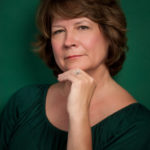 Melody McDermitt is the Executive Director of Meals and Wheels. She came to the agency in 1980 to work with the rural Senior Center Program. She came to Meals & Wheels from the Area Agency on Aging where she worked with programs in a six county area. Prior to her work in Waco Melody was an Extension Home Economist in Oklahoma. She has a degree in Home Economics and has done graduate work in Public Administration. Melody’s gifts are for building a team of employees who value older adults, and work to help older adults be seen as valued members of the community.
Melody McDermitt is the Executive Director of Meals and Wheels. She came to the agency in 1980 to work with the rural Senior Center Program. She came to Meals & Wheels from the Area Agency on Aging where she worked with programs in a six county area. Prior to her work in Waco Melody was an Extension Home Economist in Oklahoma. She has a degree in Home Economics and has done graduate work in Public Administration. Melody’s gifts are for building a team of employees who value older adults, and work to help older adults be seen as valued members of the community.
The Act Locally Waco blog publishes posts with a connection to these aspirations for Waco. If you are interested in writing for the Act Locally Waco Blog, please email [email protected] for more information.
